PRECIS
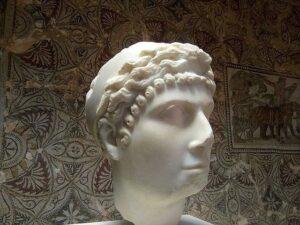
Roman bust of Cleopatra Selene II, daughter of Cleopatra VII of Egypt and Roman triumvir Mark Antony, as well as wife of Juba II of Mauretania in the Archaeological Museum of Cherchell, Algeria. Author Pericles of Athens, 31 May 2018, CC0 1.0 Universal Public Domain Dedication.
The U.S. State Department’s proposed renewal of a five-year ban on the importation of Algerian ‘cultural heritage’ raises many questions – the simplest is the one-word question, “Why?”
Algeria has ancient sites of interest dating to the Roman period. Algeria has a famous Kasbah. But Algeria is not known as an entrepot for the smuggling of ancient art. Far from it – there is no evidence whatsoever for a pattern of looting placing its sites at risk, and no U.S. market in looted Algerian artifacts. UNESCO’s reporting tells us that Algeria’s archaeological sites are at risk due to neglect by its government, a severe lack of funding for training or preservation, and rampant corruption that permits modern development on and adjacent to fragile ancient environments. Algeria’s government policy is to eliminate Christian churches and oppress Christian citizens, to convert synagogues into mosques, and to look the other way when Jewish cemeteries are defaced and graves are plundered. Algeria’s rigid, authoritarian control of scholarship permits no questioning or discussion of government cultural policy.

Djemila, depiction of sacrifice, Roman, 30 March 2006, Author Harmony Lameche, CCA-SA 2.0 Generic license.
The only current work being done to increase documentation and bring heritage management up to modern standards are projects funded by the U.S. Embassy and organized by a U.S. nonprofit closely associated with the State Department.[1] While such documentation projects are valuable and should be encouraged, it is doubtful whether a U.S. Embassy-funded project counts as ‘self-help.’
Under these circumstances, there can be only one reason Algeria has an agreement with the U.S. today, one which will likely be renewed for another five years. The State Department’s Bureau of Educational and Cultural Affairs views Algeria as just one more box to be checked on its ever-growing list of countries in North Africa and the Middle East where U.S. import restrictions have closed off public access to art and artifacts.
The renewal of the Algerian MOU.
In late 2023, the People’s Democratic Republic of Algeria asked for a Five-Year Extension of its 2019 Memorandum of Understanding (MOU) imposing import restrictions on cultural property with the U.S. Algeria’s request sought to block U.S. importation of virtually all objects – everything made by human hands in Algeria from 2.4 million years ago until modern times. In January 2023, the Cultural Property Advisory Committee heard brief public testimony on the renewal request. Algeria provided no information supporting the renewal to the public. The Committee for Cultural Policy, Global Heritage Alliance, the Association of Art Museum Directors (AAMD) and several numismatic and collecting organizations[2] each submitted extensive written testimony objecting to specific aspects of the proposed renewal.[3]

The Casbah of Algiers, between tradition and modernity, Author Nour Abdelatif, 4 September 2014, CCA-SA 4.0 International license.
The CPIA provides for the U.S. to enter into agreements with foreign nations to temporarily restrict the importation of significant cultural items as part of a multi-national effort to close off markets and deter looting of ancient archeological sites. Congress granted CPAC the ability to make recommendations for five-year-long import restrictions only on objects that are shown to be at current risk of looting.[4] The law allows restrictions to halt importation of rare ethnographic objects, which U.S. law limits to products of tribal, non-industrial societies, excluding common objects and “trinkets.”
The most important criterium that a requesting country must satisfy is that it take its responsibility to protect its own heritage seriously. Regrettably, Algeria’s archaeological and historical sites currently suffer from severe neglect, resulting in the destruction or disappearance of elements of important ancient monuments and threatening the preservation of whole ancient assemblages. Evidence presented to the State Department and the Cultural Property Advisory Committee, both in 2018 and 2024, showed that Algeria’s protection of its monuments and cultural heritage has been widely criticized.
The Association of Art Museum Directors’(AAMD)[5] submission to the Cultural Property Advisory Committee identified serious neglect at the following sites:
- Tipasa World Heritage Site, an ancient Roman military colony, has suffered deliberate destruction, unmitigated erosion due to rising sea levels, illegal activities, the use of inappropriate restoration techniques, and substandard conditions for the site’s [6]
- Algiers’s Kasbah World Heritage Site UNESCO report states that 71 percent of the buildings have been surveyed since June 2020, of which 48 percent are in “very poor” condition,[7] and today its historical landscape is replete with decrepit buildings and vacant lots.[8]
- Urban building is encroaching on ancient Mila.[9]
- Development of the El Hamdania commercial port threatens several ancient sites, including Cherchell, Roman Caesarea.[10]
- The Algerian Ministry of Culture’s budget has been cut from $313.8 million in 2014 to $132.7 million in 2018, severely impacting site preservation and maintenance across the country.[11]
The AAMD’s submission stated that:
“Corruption’s corrosive effect on administrative bodies has negatively impacted the state of cultural preservation in Algeria, as important historical sites have suffered decay in the face of ineffective oversight.”[12]
Algeria’s current president, Abdelmadjid Tebboune, came into office promising a “New Algeria” in which political and economic corruption would not be tolerated, but Algeria’s population continues to believe that its corruption level is among the highest in the world, according to Transparency International. In January 2023, ministers who served under the former Bouteflika regime were sentenced in absentia on corruption charges.[13] By April of 2023, five of President Tebboune’s own new ministers were arrested and imprisoned after accusations of political and financial corruption.[14] Unfortunately, neither corruption nor protection of heritage in Algeria shows signs of improving.
Placing nationalist property rights over human rights.
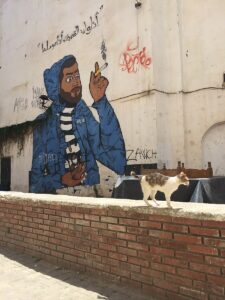
Casbah Cat and Art 2019, Author Dallaland, 15 June 2019, CCA-SA 4.0 International license.
Algeria’s continuing failure to meet the criteria of U.S. law should preclude renewal of the MOU, but it is likely that under its current administration, the Bureau of Educational and Cultural Affairs at the State Department will renew it, just as it has renewed almost every other MOU – some now running for more than thirty years.
Many U.S. cultural property agreements are with authoritarian nations. These agreements recognize the government’s ownership claims to virtually all cultural property, including the personal property of individuals and the communal property of religious and ethnic groups. Through the listing of minority people’s religious artifacts on Designated Lists, and by the inclusion of common and relatively recent antiques as “ethnographic” objects under the CPIA, the United States has implicitly recognized the authority of oppressive nationalist regimes in the Middle East to control religious and historical objects associated with Jewish and Christian communities, as well as the art and the ordinary craft production of minority peoples.[15]
The Middle East and North Africa are not the only places where the U.S. has signed unjustified MOUs with authoritarian governments. In its pursuit of restrictive cultural property agreements, the Department of State signed an extension of an MOU with the People’s Republic of China on January 11, 2024, despite the Chinese government’s genocidal treatment of oppressed minorities and deliberate destruction of religion, language and culture in its Tibetan and Uyghur regions.
Is the Agreement with Algeria legally justified?
CPAC’s task is to review Algeria’s request for renewal and determine if the country’s situation meets all four of the criteria under U.S. law:
- Is there a current situation of looting that jeopardizes the cultural patrimony of Algeria?
- What has Algeria done to stop looting and to protect extant heritage sites?
- Has the 2019 MOU has been “of substantial benefit in deterring looting” during the last five years, and if not, is a less drastic solution than import restrictions available?
- Are import restrictions justified under the legal requirement that they support the general interest of the international community in the interchange of cultural property among nations for scientific, cultural, and educational purposes?
Is there a current situation of looting imperiling Algeria’s cultural heritage?
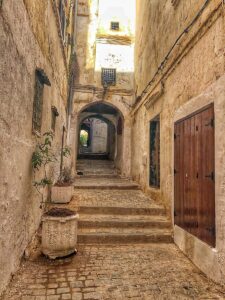
La Casbah est un endroit situé dans la capitale d’Algérie, Author Thiguemi Abersi, 1 October 2019, CCA-SA 4.0 International license.
No. Algeria’s 2018 request stated generally that looting was frequent and that Algerian police are actively involved in preventing pillage of sites, but the request failed to identify any specific incident of either looting or looting prevention nor have they been reported in the press.
There has been only one reported instance of a significant object looted or stolen from Algeria turning up in the U.S. A marble bust of Roman Emperor Marcus Aurelius was stolen during a 1996 robbery of an Algerian museum in the town of Skikda. The U.S. Immigration and Customs Enforcement Agency (ICE) seized the sculpture from Christie’s auction house in New York in 2008, where it had been offered for sale. No subsequent museum or site theft has been reported publicly. It should be noted that this item was repatriated ten years prior to the beginning of the current MOU, as U.S. law already covers such stolen objects without an MOU.
The 2018 Summary of the Algerian request, which claimed there was a significant market for looted Algerian antiquities in the U.S. was deceptive. The supposed significant U.S. market for Paleolithic artifacts turned out to be a couple of dozen items offered by two U.S. fossil shops on eBay, with objects averaging in price from $7 to $50. Prior to 2019, there were a small number of very low-value ancient stone arrowheads and lithic tools being sold on eBay. Almost all these Neolithic tools were from the same seller and the same objects were offered repeatedly.[16] There was no pillaged rock art or other prehistoric material looted from Algeria being sold in the U.S., as the 2018 Summary claimed, and there is none being sold today.
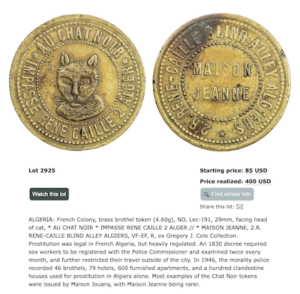
Algerian Brothel Token, 2nd quarter 20th C.
A review of auction records from all Christie’s auction houses worldwide showed sales of 14 lots of objects from Algeria from 2006 to 2018. There have been no sales at all of Algerian artifacts at Sotheby’s for the last 15 years. The only articles sold prior to that were Judaica. There were zero sales in United States since Sotheby’s and Christie’s made auction records available online in the early 2000s.
Since the implementation of the U.S. import restrictions, there have been almost no sales again in the U.S. of material even potentially covered under the CPIA, save for 10 or 20 mixed ancient and antique coins per year from a whole range of coin auction sellers, mostly of very low value, and representing the accumulated stock of decades of coins collected from North Africa.[17] We have found no U.S. market for illegal Algerian art or artifacts such that closing the U.S. to entry of coins, Judaica, antiquities or ethnological material would be of “substantial benefit in deterring a serious situation of pillage” as the statute requires.[18] Raw minerals and meteorites, which are sold from Algeria, are not covered under the CPIA. The only measurable U.S. market for Algerian goods is in legally exported contemporary crafts such as rugs and kilims.
What has Algeria done to protect its heritage since the 2019 Agreement?
Algeria’s protection of its monuments and cultural heritage is poor. According to UNESCO, Algeria’s heritage workers have not been sufficiently trained or funded, and many sites, including several World Heritage sites have suffered significantly because of incompetent management and poorly trained staff.
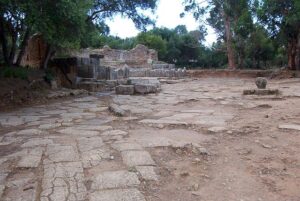
Tipasa, Algeria. Author Yelles, June 2010, CCA-SA 3.0 Unported license.
In 1982, the World Heritage Committee inscribed five Algerian sites on the World Heritage List: Djémila, M’Zab Valley, Timgad, Tipasa, and Tassili n’Ajjer. In December 1992, the Kasbah d’Algier was added. As the AAMD reported above, the government’s failure to coordinate with private owners in the Kasbah has resulted in “natural erosion, lack of maintenance of dwelling places, loss of traditional conservation techniques, uncontrolled land use, non-operational safeguarding plan, lack of coordination of actions.”[19] In the case of Tipasa, UNESCO cited “deterioration of the remains due to vandalism, theft and uncontrolled visitation causing accumulation of rubbish, lack of capacities for site conservation, unsuitable restoration techniques, and poor conservation conditions for the archaeological remains.”[20]
Five years later, Algeria appears to continue to allow archaeological sites, monuments, the Kasbah of Algiers,[21] Tipasa,[22] and the M’Zab valley[23] to suffer considerably from neglect. These are the most famous sites in Algeria – lesser-known sites are at even greater risk.[24]
Testimony presented to the CPAC in favor of renewal cited U.S. government funded digitization projects at the Bardo Museum and Algeria’s National Manuscript Center that were just getting under way.[25] No testimony was presented regarding Algerian government funding for security, maintenance, conservation or restoration activities at any sites in Algeria.
Has the MOU been of substantial benefit in deterring looting?
No. In fact, there is little evidence of looting in the past, and none being reported publicly today. The MOU cannot have substantially deterred looting in Algeria.
Has Algeria ensured that the U.S.-Algeria MOU has been in the general interest of the international community in interchange of cultural property among nations?
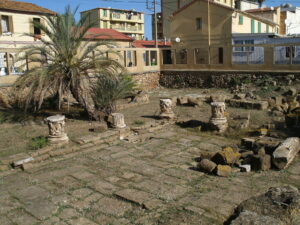
Remains of the Forum of Cesarea, Author Yelles, 2011, CCA-SA 3.0 Unported license.
No. The fourth determination requires evidence that import restrictions would be “consistent with the general interest of the international community in the interchange of cultural property.” There is no evidence to support this determination. Algerian law strictly controls transfers of historical and archaeological objects which must be periodically registered with the Ministry of Culture, even if in private hands, and which the government may confiscate at will. Algeria has never sent a traveling exhibition of the covered materials from any of its museums to the U.S. and has no plans to do so.
In Algeria, scholarship of ancient and medieval history is held suspect, as it raises ideas that do not conform to the current political perspective held by Algeria’s government. Algeria’s government also limits the circulation of ideas, prohibiting publication of any historical study without prior government approval, including outside of Algeria. Article 103 of Algeria’s heritage law states that, “Whoever publishes a work of scientific nature in Algeria or a foreign country, without authorization of the Minister of Culture, which include formerly unpublished documents conserved in Algeria and which concern its cultural patrimony, shall be fined between 50,000 and 100,000 DA. A court of law may, moreover, order the confiscation of the publication.”
Algeria has had one project involving individuals from a U.S. university in the past, the Stone Age Institute at Indiana University. While the 2018 Summary listed an “archaeological project with a U.S. company,” this turned out to be a construction company working on a tourist project, not archaeology.
Algeria claims State ownership of Jewish and Christian minority property.

Mosque of Abdallah Ibn Salam, converted building of the Great Synagogue of Oran, Algeria.
Algeria’s policy of repression of religious minorities, including Christians, Jews, and members of minority Muslim sects[26], and its failure to preserve their cultural heritage is in direct contradiction to the foundational principles of the 1970 UNESCO Convention.[27] Algeria has closed 36 Protestant churches since 2017.[28] Algerian law not only restricts religious expression that differs from that of its 99% Sunni Muslim majority;[29] members of religious minorities must obtain government permission to come together for worship, and proselytizing by non-Muslims is punished by heavy fines and prison sentences.
The Algerian government has allowed the destruction of Jewish and Christian cemeteries. More than 30 Christian tombstones at the La Reunion War Cemetery were smashed, and their graves desecrated in 2017,[30] as were graves at another Christian cemetery. The government has forbidden attempts by Jews and Christians to restore synagogues and churches.
Over the last seven years, the State Department has increasingly advocated for cultural property MOUs with foreign nations that recognize those nation’s claims and seizures of all cultural property, including the personal property of individuals and the communal property of religious and ethnic groups.
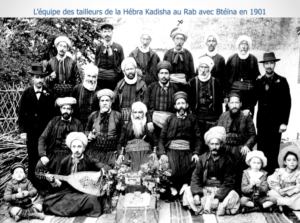
Chevra Kadisha burial society, Algeria 1901, courtesy JIMENA.
Through the inclusion of minority religious books and ritual objects on Designated Lists, the State Department has also recognized the authority of oppressive nationalist regimes in the Middle East over Jewish and Christian artifacts. Jewish and other minority peoples have been driven out of Algeria, Syria, Libya, Iraq, and Egypt – regions where they lived for thousands of years – and the US has given their oppressors ownership of their community histories.
These nationalist claims violate Article 17 of the Universal Declaration on Human Rights,[31] which hold that:
- Everyone has the right to own property alone as well as in association with others.
- No one shall be arbitrarily deprived of his property.
These provisions include in their protection the communal property of various religious and ethnic minorities.
The many national cultural patrimony laws in the Middle East and North Africa cover property of individuals and groups that currently exist, as opposed to vanished ancient cultures. Such laws seizing property and not allowing it to travel with refugees, for example, are in violation of the Universal Declaration of Human Rights.
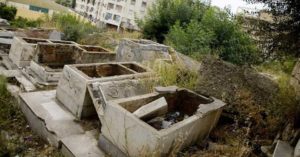
Vandalized Jewish Cemetery, Azzefoun, Algeria.
The State Department continues to promote agreements that legitimize the seizure of confiscation of Jewish and Christian property. When a Designated List is made up of general descriptions of objects in ordinary use by Muslim, Christian, and Jewish communities, using the disingenuous term “Ottoman” to cover all objects from Turkey through Iraq and across North Africa, the term is both inaccurate and so comprehensive that it covers the possessions of minority groups whose rights to their heritage is denied without even naming them as the owners or creators in a Designated List. This amounts to a coverup, in which the State Department can claim Jewish and Christian objects are not included – when they are. Unless the artifacts and heritage of Jewish and Christian minorities are specifically excluded from a Designated List, they are included for U.S. Customs purposes.
This bureaucratic “re-write” of the law by the State Department has winners and losers. The winners are the corrupt, dysfunctional dictatorships of the Middle East.[32] The losers are the fleeing and often expelled and persecuted Jewish and Christian minorities of those nations. The Algerian MOU grants de facto recognition to the Algerian government’s ownership of the property it confiscated from its Jewish citizens.

Algerian Jew.
The history of the Jewish communities of Algeria in the modern era is dramatic and heartrending. Just sixty years ago, after a 3000-year history in Algeria, 130,000 Jews fled to France together with Algeria’s French settlers, many of whom were pied noirs, people of French and other European descent who were born in Algeria during the period of French rule from 1830 to 1962. The choice for the Jews and the pied noirs forced to leave Algeria was described as “la valise ou le cercueil” (the suitcase or the coffin).[33]
From June 1830 until its independence, Algeria was administratively part of France. Ten percent of Algeria’s population was non-Muslim, Christian, mostly Catholic, and Jewish. In 1960, there were 1,050,000 non-Muslim civilians resident in Algeria, including 130,000 Jews. All the Jews and most of those of French ancestry were born in Algeria and had lived there for decades.
Although for centuries, Jewish communities held a relatively secure place under Muslim rule as dhimmi, “protected people” (certainly safer in comparison to the oppression Jews faced in Europe), a heavily oppressive Muslim rule in Algeria at the beginning of the 19th century meant that the Jews had welcomed the French as liberators in 1830. The Décret Crémieux of 1870[34] automatically granted French citizenship to all “native Israelites,” that is, all Algerian Jews.

Jewish woman in Algeria.
Algerian Jews were stripped of French citizenship during World War II, but it was reinstated in 1943. After the war, Jews in Algeria were caught between colonial and independence factions. The community attempted to remain neutral despite bombings of synagogues and the murder of rabbis. However, the already precarious situation of Jewish residents worsened with the burning of the Great Synagogue in Algiers in December 1960 and the murder of the famous Jewish musician, Sheikh Raymond Leyris, a symbol of Jewish-Algerian shared culture, in June 1961.
Rejected by their own country, almost the entire Jewish population fled with the 800,000 French settlers before declaration of Algerian independence on July 3, 1962. Only a few thousand Jews out of several hundred thousand remained in Algeria.
Since that time, the shrinking Jewish community has struggled to maintain their millennia-long place in Algeria. The Great Synagogues of Algiers or Oran have been turned into mosques. The main synagogue of Constantine is now a parking lot. Jewish cemeteries in Algeria have been viciously attacked, with headstones destroyed and tombs opened and left exposed.
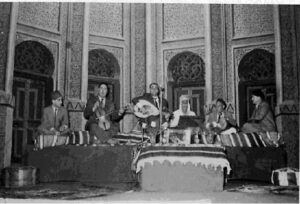
Abdelhamid Benkartoussa, Sylvain Ghrenassia, Raymond Leyris, Belamrri Larbi, Nathan Bantari, Haim Benbala, Author unknown, 28 November 2010, Wikimedia Commons.
The U.S. Customs standard of enforcement means that members of the Jewish community in France and other parts of Europe would have to prove their long-term ownership of any item outside Algeria in order to bring it into the U.S. In this respect, it is especially troubling that import restrictions could be based upon U.S. sales of Algerian cultural items which for past decades have been overwhelmingly items of Judaic origin.
Recommendations on U.S. cultural policy on Algeria.
Passage of the CPIA in 1983 was impelled by the fears of fifty years ago, that an uncontrolled international market for ancient art from countries that did not have the means to protect archaeological sites could result in the loss of the entire record of previously unknown and little understood human history. Congress granted the CPAC the ability to make recommendations for import restrictions that would reduce archaeological and historical losses by imposing five-year bans on imports of objects that were shown to be at current risk of looting. The legislation gave a moral boost to archaeologists everywhere by recognizing their contribution to preserving human history. The law also obliged source country governments to do the right thing along with the United States by taking self-help measures to protect archaeological sites and to curb the markets for looted objects in their own countries.

Roman mosaic of the series of fieldworks exhibited at the Archaeological Museum of Cherchell, Algeria, 15 November 2011, Unknown, public domain.
Based upon the facts as outlined above, Algeria’s request for renewal of import restrictions under the Cultural Property Implementation Act fails to meet the criteria set forth in the statute.
If any renewal of the MOU is signed, it must be limited in scope to objects subject to extensive current looting and therefore legally allowed to be included under the CPIA. Algeria should be held accountable during this proposed renewal for its failure to preserve and protect the country’s cultural heritage over the last five years in order to meet the reasonable benchmarks set by Congress when it mandated self-help measures. Under no circumstances should import restrictions be applied to items that are neither archaeological nor ethnological in character according to the standards set in the statute and elucidated by the Senate in its deliberations. Under no circumstances should Jewish, Christian and Muslim minorities suffer through the prohibition of import of their heritage, which the Algerian government has shown no interest in preserving except for its government’s political purposes.
The only justification for limiting the US market for archaeological materials is to give source countries the opportunity to build their own enforcement capacity, pass legislation, build museums and institutions of historical learning, and educate its people to appreciate the social benefits of preserving and honoring its past. Import restrictions must also only be undertaken when there is assurance that a source country will honor and care for all, not just some of its history.
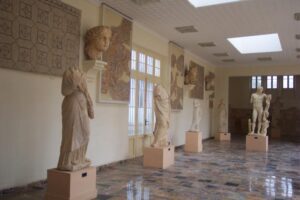
Statues in the Archaeological Museum of Cherchell, Algeria. Author Yves Jalabert, 30 April 2000, CCA-SA 2.0 Generic license.
Algeria’s original request for U.S. import restrictions stressed that the State had legal control of all cultural resources and movable objects and made dubious claims that these were threatened by illegal removal from the country for sale. Yet the evidence continues to make clear that the key problems preventing the preservation of Algerian heritage have nothing to do with the world market. They have everything to do with the Algerian government’s failure to invest in heritage projects and to ensure that there are competent heritage management staff and a skilled body of museum workers, conservators, and capable workers for digital documentation and other necessary work.
While there is much that can and should be done to provide grants to support local heritage work and to encourage Algeria’s government to preserve the country’s broader cultural heritage, there is no benefit to Algeria’s heritage in placing import restrictions on movable goods in the U.S. Looting and smuggling are not the problem. Algerian governmental neglect, indifference, and the lack of core competencies in heritage management are the problem.
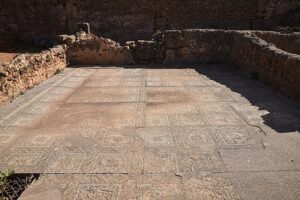
Tipasa, Mauretania Caesariensis, Author ‘Following Hadrian”, 24 October 2022, CCA-SA 2.0 Generic license.
CPAC cannot legitimately find that the Algerian government meets the legal requirements for import restrictions. Other means of assisting Algeria by broadening Algerian cultural development and helping to support an open dialog with its academics and archaeologists would better address their needs. Developing loan exhibitions from Algeria and other direct connections between Algerian governmental and cultural institutions and museums in the United States would not only directly benefit Algerian cultural institutions, but they would also encourage travel to Algeria and help to achieve that country’s primary goal for its heritage – to increase tourism and tourist revenue. U.S. institutions welcome such exchanges.
Direct cultural links that familiarize U.S. citizens with Algeria and help to develop cultural management skills for Algerians would benefit both nations. The greatest mutual benefits will be found, not in the unwarranted imposition of import restrictions, but in increasing cultural cooperation between institutions in the U.S. and Algeria, and through direct civil-society assistance through the State Department’s Bureau of Educational and Cultural Affairs.
NOTES
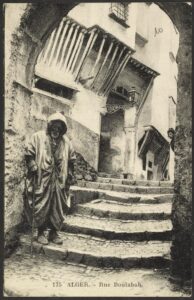
Postcard of Algiers, October 19, 1932, Ideale, Part of the Cities and Sites Postcard collection in the Getty Research Institute Library’s special collections.
[1] See Preserving Algerian Cultural Heritage: Bardo Museum Launches Digitization Lab: Antiquities Coalition Leads International Team in Building Digital Infrastructure, The Antiquities Coalition, June 6, 2023, https://theantiquitiescoalition.org/preserving-algerian-cultural-heritage-bardo-museum-launches-digitization-lab/
[2] These included the Ancient Coin Collectors Guild, the American Numismatic Association, and the International Association of Professional Numismatists.
[3] All comments are available at https://www.regulations.gov/document/DOS-2023-0040-0001/comment.
[4] 19 U.S.C. § 2602(a)(1)(A) and 19 U.S.C. § 2602(a)(2)(A)
[5] The Association of Art Museum Directors , Statement of the Association of Art Museum Directors on the Proposed Extension of the Memorandum of Understanding between the Government of the United States of America and the Government of the People’s Democratic Republic of Algeria Concerning the Imposition of Import Restrictions on Categories of Cultural Property of Algeria, hereafter AAMD 2024 Statement on Algeria) https://www.regulations.gov/comment/DOS-2023-0040-0047 , The Association of Art Museum Directors (AAMD) is a professional organization of over 220 directors of major art museums throughout the United States, Canada, and Mexico, https://aamd.org/.
[6] AAMD 2024 Statement on Algeria, supra, citing to Tipasa, Algeria, WORLD HERITAGE CTR. (2021), https://whc.unesco.org/en/soc/4231.
[7] AAMD 2024 Statement on Algeria, supra, citing to Kasbah of Algiers, Algeria, WORLD HERITAGE CTR. (2023), https://whc.unesco.org/en/soc/4400.
[8] AAMD 2024 Statement on Algeria, supra n.3, citing to Stephen Zacks, Cultural Capital: The Ongoing Regeneration of Algiers’ Casbah, ARCHITECTURAL REV. (Sept. 19, 2019), https://www.architectural-review.com/essays/cultural-capital-the-ongoing-regeneration-of-algiers-casbah.
[9] AAMD 2024 Statement on Algeria, supra n. 3, citing to Lamia Bouldjemar et al., The Old City of Mila (Algeria): A Heritage in Distress, 8 INT’L J. INNOVATIVE STUD. SOCIO. & HUMAN. 475, 475 (2023), https://ijissh.org/storage/Volume8/Issue1/IJISSH-080151.pdf.
[10] AAMD 2024 Statement on Algeria, supra n.3, citing to Rafik Khellaf et al., Risks and Destruction of Coastal Archaeological Sites in Algeria – The Case of the Coast of El Hamdania, 54 LIBYAN STUD. 187, https://www.cambridge.org/core/journals/libyan-studies/article/risks-and- destruction-of-coastal-archaeological-sites-in-algeria-the-case-of-the-coast-of-el-hamdania/AAC3E279D6C045071672D31E3D858921
[11] AAMD 2024 Statement on Algeria, supra n.3, citing to Reem Hg Furjani, Algeria Country Report, MED CULTURE 10–11 (2018), available at http://www.medculture.eu/country/report-structure/algeria.html.
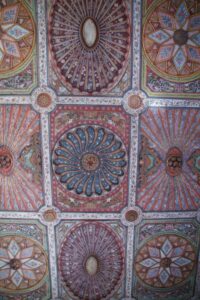
Ceiling of a Casbah building, Author Yves Jalabert, 4 October 2010, CCA-SA 2.0 Generic license.
[12] Statement of the Association of Art Museum Directors on the Proposed Extension of the Memorandum of Understanding between the Government of the United States of America and the Government of the People’s Democratic Republic of Algeria Concerning the Imposition of Import Restrictions on Categories of Cultural Property of Algeria (AAMD 2024 Statement on Algeria), Association of Art Museum Directors, January 30, 2024, citing to Julia Stanyard and Rim Dhaouadi, Culture in Ruins: The Illegal Trade in Cultural Property Across North and West Africa, ENACT 8 (Nov. 2020), https://enact-africa.s3.amazonaws.com/site/uploads/2020-11-12-culture-in-ruins- main-paper-01.pdf (“Corruption in cultural ministries and the management of sites is seen as a driving factor in the illegal trade of cultural antiquities in . . . Algeria,” but also noting that Algeria’s Gendarmerie Nationale operates a cultural-heritage protection unit that has enjoyed at least some success in dismantling trafficking networks); see also id. at 15 (“In Algeria, the Office of Cultural Property Management and Exploitation and the National Archaeology Research Centre, are also beset by corruption allegations implicating high-level political figures and cultural heritage officials.”).
[13] Algeria Judiciary: 20 years imprisonment, in absentia, against former Energy Minister Chakib Khelil, Middle East Monitor, January 20, 2023. https://www.middleeastmonitor.com/20230120-algeria-judiciary-20-years-imprisonment-in-absentia-against-former-energy-minister-chakib-khelil/
[14] Enrique Fernández , Algeria: Tebboune tries to get around suspicions of corruption plaguing his government, Atalayar, April 14, 2023, https://www.atalayar.com/en/articulo/politics/algeria-tebboune-tries-get-around-suspicions-corruption-plaguing-his-government/20230414114149182547.html. The ministers recently accused of corruption included Minister Delegate for Small Enterprises Nassim Diyafat, Abdulaziz Jarad and Ayman bin Abdul Rahman, Samia Mualfi, Minister of Tourism, and Kamal Beljoud, the Minister of Environment.
[15] Despite the genocidal treatment of oppressed minorities in China’s Tibetan and Uyghur regions (coupled with the Chinese government’s desire to commodify and monopolize the trade in ancient Chinese art) the Department of State signed an MOU with China in 2013, 2015, 2019 and again on January 11, 2024.
[16] eBay search June 22, 2018, Algeria Lithic Paleolithic Neolithic result was 38 lots, mostly from one U.S. seller, ‘Earthsancientgifts’ of 1-10 items per lot, average 2 items. Prices for U.S. lots were $7.99 (for a lot of 5 pieces) to $39.99 for a large single specimen 3.5 inches in length (“from an old collection 50-60s”).
[17] See, for example, a brothel token at Stephen Album Rare Coins, auction 13-15 May 2021, est. 100-150 USD.
[18] 19 U.S.C. § 2602(c)(2)(B)
[19] “State of conservation of properties inscribed on the World Heritage List,” World Heritage Committee (July 2-12, 2017) 156, Krakow, Poland, http://whc.unesco.org/archive/2017/whc17-41com-7B-en.pdf
[20] UNESCO, “Addendum, State of conservation of properties inscribed on the World Heritage List,” World Heritage Committee (July 2-12, 2017) 67, Krakow, Poland, 67., http://whc.unesco.org/archive/2017/whc17-41com-7BAdd-en.pdf
[21] UNESCO reports for 2023 note the issues faced by the Kasbah as “Changes in traditional ways of life and knowledge system, Erosion and siltation/ deposition, Natural erosion, Lack of coordination of actions, Lack of maintenance of dwelling places, Land conversion: Change in the land use plan, Loss of traditional conservation techniques, Management systems/ management plan: Non-operational safeguarding plan, Uncontrolled land use.” UNESCO, https://whc.unesco.org/en/soc/4400
[22] UNESCO reports factors affecting Tipasa in 2021: “Deliberate destruction of heritage, Erosion and siltation/ deposition, Housing, Illegal activities, and Unsuitable restoration techniques, and poor conservation conditions for the archaeological remains.” https://whc.unesco.org/en/soc/4231/
[23] UNESCO last analyzed the M’Zab valley in 2008, finding “a) Development linked to socio-economic changes and population growth causing major urban pressure; b) Degradation of the environment, uncontrolled urban growth in the palm groves and the bed of the Oued, visual impact of new buildings on the surrounding hill c) Lack of a Safeguarding Plan ; d) Loss of craftsmanship and knowledge of traditional materials for rehabilitation of the vernacular architecture ; e) Loss of the traditional network for the management and distribution of water; f) Risk of flooding and pollution of the water table.” https://whc.unesco.org/en/soc/2548
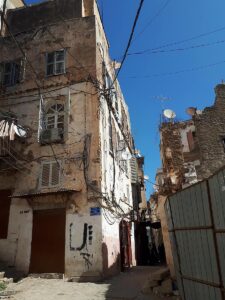
La Casbah, from series ‘African people at work,’ Author HABIBECHE Mustapha, 2 September 2017, CCA-SA 4.0 International license.
[24] See, for example, the concerns over lack of funding, use of improper techniques, and lack of fundamental competence of restoration and conservation authorities described in Fatima Zahra Makhloufi, Naima Hadj Mohamed, Abdelmadjid Hamouine, “Intervention on Ksourien Inheritance: Between Planning and Autoconservation, Example of Kenadsa, Bechar, Algeria,, International Journal of Conservation Science, Volume 12, Issue 1, January-March 2021: 51-66.
[25] Testimony by Peter Herdrich, CEO of Cultural Capital Group. Mr. Herdrich (Executive Project Director, Algerian Cooperative Plan for the Digitization of Heritage, CEO, Cultural Capital Group) discussed a digitization project for Algerian museum and private collections paid for by the US government which also involved the Antiquities Coalition. Mr. Herdrich maintained that this US government funded program showed that Algeria was engaged in protecting its own cultural heritage. See also https://www.linkedin.com/posts/peter-herdrich-69190012_preserving-algerian-cultural-heritage-bardo-activity-7087831008116396032-zeb6/?trk=public_profile_like_view.
[26] 2022 Report on International Religious Freedom: Algeria, U.S. DEP’T STATE (2022), https://www.state.gov/reports/2022-report-on-international-religious-freedom/algeria/. Muslim minorities include Ahmadi, Shia, and Ibadi Muslims.
[27] 1970 UNESCO Convention on the Means of Prohibiting and Preventing the Illicit Import, Export and Transfer of Ownership of Cultural Property, Article 5, sub-part (a), available at https://en.unesco.org/about-us/legal- affairs/convention-means-prohibiting-and-preventing-illicit-import-export-and.
[28] 2022 Report on International Religious Freedom: Algeria, U.S. DEP’T STATE (2022), https://www.state.gov/reports/2022-report-on-international-religious-freedom/algeria/.
[29] Algeria: Crackdown on the Protestant Faith, HUM. RTS. WATCH (Oct. 24, 2019), https://www.hrw.org/news/2019/10/24/algeria-crackdown-protestant-faith.
[30] Zack Udin et al., Destruction of Cemeteries, U.S. COMM’N INT’L RELIGIOUS FREEDOM (Sept. 2021), https://www.uscirf.gov/sites/default/files/2021-09/2021%20Factsheet%20-
%20Destruction%20of%20Cemeteries_0.pdf (“In 2018, a group of young people desecrated more than 30 Christian graves at the La Reunion War Cemetery in Oued Ghir, a town near the northern city of Bejaia. The perpetrators smashed the tombstones and ransacked the graves. The attack came after another Christian cemetery in Ain M’lila, near Constantine, was vandalized a few weeks earlier.”).
[31] Universal Declaration of Human Rights, https://www.un.org/en/about-us/universal-declaration-of-human-rights.
[32] According to Human Rights Watch’s 2024 analysis, Algeria has a very poor human rights record that has worsened recently: “Algerian authorities have intensified their repression of freedoms of expression, the press, association, assembly, and movement, as part of their continued efforts to crush organized contestation. They have dissolved major civil society organizations, suspended opposition political parties and independent media outlets, and continued to use restrictive legislation to prosecute—including on dubious charges of terrorism and receiving funding to harm state security—human rights defenders, activists, journalists, and lawyers, pushing some of them to flee into exile.” https://www.hrw.org/world-report/2024/country-chapters/algeria. The U.S. State Department’s most recent report on cultural rights and censorship states: “The Ministry of Culture reviewed the content of films before they could be shown, as well as books before importation. The Ministry of Religious Affairs did the same for all religious publications. The law gives authorities broad power to ban books that run counter to the constitution, ‘the Muslim religion and other religions, national sovereignty and unity, the national identity and cultural values of society, national security and defense concerns, public order concerns, and the dignity of the human being and individual and collective rights.’ It further prohibits books that ‘make apology for colonialism, terrorism, crime, and racism.’”
[33] This is a slogan by the Algerian People’s Party, “seen on leaflets distributed to mailboxes in Constantine as early as 1946. “La valise ou le cercueil” was subsequently taken up by certain Algerian nationalists against the pied-noirs population during the Algerian War.” Wikipedia, https://en.wikipedia.org/wiki/La_Valise_ou_le_Cercueil.
[34] Décret Crémieux; Wikipedia, https://en.wikipedia.org/wiki/Cr%C3%A9mieux_Decree
This website is provided for general information purposes only. Its publications are not legal advice in respect of the laws of the United States or the relevant countries described herein. It does not purport to be complete or to apply to any particular factual or legal circumstances. It does not constitute and must not be relied or acted upon as legal advice or create an attorney-client relationship with any person or entity. Legal advice should be obtained from legal counsel qualified in the relevant jurisdictions when dealing with specific circumstances. Neither Cultural Property News writers, staff, employees, the Committee for Cultural Policy nor any contributor to this website is holding itself, himself or herself out as being qualified to provide legal advice in respect of any jurisdiction.
 Timgad, Roman ruins, Author Yane Casouf, 8 July 2019, CCA-SA 4.0 International license.
Timgad, Roman ruins, Author Yane Casouf, 8 July 2019, CCA-SA 4.0 International license. 

